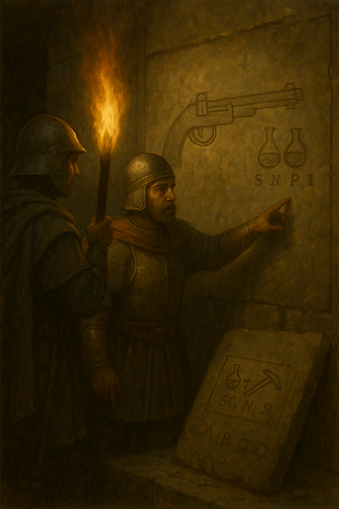
Maiko's Note
"Ah, yes, the Empire's grand plan: to recover ancient technology... from the same ship whose failure stranded them there in the first place. But don't worry - I'm sure digging up 700-year-old power cores and half-melted circuit boards will definitely turn out better this time."
Technology and Knowledge After the Fall
Shindjal: Te Irushinal
Faction:
Nodilani
"The old world broke. But the fire never died."
1. Overview
Seven centuries have passed since the generational ship Theseus brought humanity to Madun. Though knowledge was carved in stone before the ship's systems died, the civilization that rose from its ashes is not a mirror of Earth - but a tapestry of what was preserved, what was misunderstood, and what was intentionally left behind.
Today, Madun stands in a state of asymmetric development: complex in spirit and structure, yet far from the technological heights of its past. Tribes and empires wield swords and bows, domesticate massive beasts, and rely on natural forces - while fragments of science, etched into stone, sit guarded in great halls of knowledge.
2. The Legacy of Project Stonevoice
In the final days aboard Theseus, engineers and scholars initiated Project Stonevoice, an effort to preserve critical knowledge by carving it into stone. The goal was noble: survival through memory.
But those who carved the stars into walls did not imagine their descendants would lose the wheel.
What Was Preserved:
Advanced concepts: fusion, orbital mechanics, genetics, chemistry, language systems
Scientific principles: thermodynamics, physics, astronomy, medicine
Cultural memory: poetry, laws, family records, tribal names
What Was Not:
Foundational technologies: steam engines, pistons, water mills, combustion
Common knowledge: smelting techniques, pulley construction, pressure systems
Stepwise processes: how to progress from basic tools to modern systems
Most importantly, many weapon schematics - particularly for combustion-based systems - were left incomplete.
Some say this was an oversight.
Others whisper it was deliberate.

3. The Dreamers’ Silence
Among the final archivists were quiet believers in Dunlin’s Dream - a vision of a humanity reborn, free from the hierarchies and violence that defined Earth’s last centuries.
Fearing that weaponry would allow corrupt power to rise again, they intentionally fractured or omitted key designs for:
Gunpowder-based firearms
Explosives and incendiaries
Rapid-fire mechanisms
Automated killing systems
These omissions now form a gap in the imperial arsenal, one the Imperi kòu Handjelani seeks to fill by raiding or seizing sacred records from tribal archives - especially the Endulani Hall of Records (Bvaborul kòu Shint’twal), where many believe lost schematics are hidden.
4. The Role of the World Itself
But not all regression is loss. Some is adaptation.
Madun itself does not demand the same tools Earth once did. The ecosystem is filled with lifeforms and natural forces that replace the need for machines:
The Krovil - massive land beasts used for transport, plowing, and as living engines of war.
Shadunar - gliding sky-beasts bonded to riders, rendering airships unnecessary.
Fleshtrees - neural-reactive groves that serve as archives and burial grounds.
Thermal vents, mist currents, and fungal networks - all offer forms of energy and connection that bypass traditional industrial infrastructure.
Where Earth would have built machines, Madun grew relationships - between human and beast, spirit and soil, tribe and tide.

5. The Present State of Technology
Madunese civilization today reflects a balance of ingenuity and reverence, marked by rediscovery rather than invention:
Medicine: Advanced herbalism, fungal cures, basic surgery; pre-landing records still studied
Metallurgy: Mastery of bronze, iron, and limited steel; no mass industry
Energy: Manual labor, thermal vents, wind/water mills (tribal), fusion revival in progress (Empire)
Weapons: Bows, blades, siege engines; rare firepowder fragments (suppressed or unstable)
Transportation: Beast-based (Krovil, horses), riverboats, airbeast riders; no combustion vehicles
Communication: Runners, mistcodes (Endulani), beacon fires, carved stone messages
Computing: Lost; only fragments of digital logic remain in sacred records
Construction: Skilled masonry, forest-integrated architecture, fungal materials in Endulani design
6. The Climb Begins Anew
Knowledge was not erased. But the path to it was scattered - by time, fear, and love.
The tribes of Madun do not walk backward. They walk a new way forward, one where memory is sacred, and trust must be earned again - not just in machines, but in each other.
The Empire seeks to reclaim the old world.
The Endulani seek to protect the quiet threads of wisdom.
And somewhere in between, new steps are being carved into the mountain.
Each one… a beginning.

7. The Embers Beneath the Ashes
Though much was lost when the Theseus fell silent, the memory of Earth's machines never truly vanished. In carved records, in preserved schematics and spoken myth, the knowledge sleeps and waits. The Imperi kòu Hanjelani hungers to awaken it, seeing in the old power a path to order and dominion reborn. Others seek it too, for healing, for defense, for the hope of rekindling a future that is neither a return nor a regression, but something new: forged in the soil of Madun, shaped by seven centuries of survival.

Maiko's Note
"Ah, yes, the Empire's grand plan: to recover ancient technology... from the same ship whose failure stranded them there in the first place. But don't worry - I'm sure digging up 700-year-old power cores and half-melted circuit boards will definitely turn out better this time."


